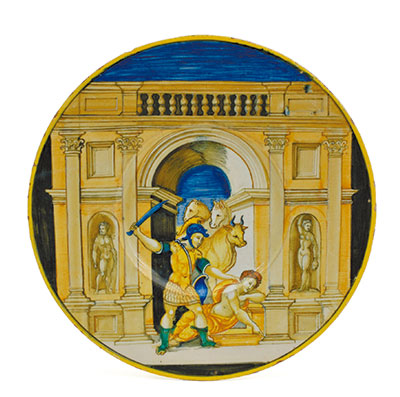
Cao Zhen caozhen0806@126.com A SELECTION of 150 ceramic pieces from Italy’s International Museum of Ceramics in Faenza are on display at the newly opened “Majolica: An Exhibition of the Legacies of 1,000 years of Italian Ceramics” at Shenzhen Museum, portraying Italian ceramic history from the Middle Ages to the 20th century. “The exhibition, through its rich structure and multiplicity of artistic proposals, aims to illustrate Italian ceramic culture that has had international influences,” said Claudia Casali, director of the Faenza museum. Faenza, a small town with a rich cultural heritage in Northern Italy, has engaged in ceramic production since the Middle Ages. The International Museum of Ceramics in Faenza is the world’s largest ceramics museum with over 50,000 pieces from classical amphora to the works of Marc Chagall and Pablo Picasso. Italian glazed pottery was first seen in the Roman Empire period and the glaze on such pottery was thick and rough. Majolica is Italian tin-glazed pottery dating from the Renaissance period. It is decorated in colors on a white background, sometimes depicting historical and mythical scenes. “In China’s Tang Dynasty (618-907), when Chinese white ware was exported to the Middle East, Islamic workshops were unable to duplicate it. Instead, they manufactured fine earthenware bowls with the desired shape, and covered them with a white glaze rendered opaque by the addition of tin, an early example of tin-glazing,” said Guo Xuelei, vice curator of Shenzhen Museum. “Later, in the 13th century, tin-glazing technology was introduced from the Middle East to North Africa, via the Mallorca Island in Spain to Italy, and the production of Majolica began.” The Renaissance was Faenza pottery’s golden age, for it bred the prosperity of Majolica. From the end of the 15th century to the first half of the 16th century, in the liberal and esoteric atmosphere of the humanity art, the Italian tin glazed pottery technology reached its peak and enjoyed an exaulted status with painting, sculpture, and architecture of the same period. The exhibition shows stylistic influences coming in from different ages and countries, such as the “blue and white” Italian porcelain that clearly imitates Chinese ceramics (also known as the “chinoiseries”), a trend that arrived in Europe starting from the 17th century and fully developed in the 18th century. Due to the rise in trade with China and East Asia, Chinese porcelain, especially the blue and white porcelain, was exported in large quantities, which led to the successive imitations of all European countries. The products of Majolica were gradually tinted with a strong Oriental taste. In the late 18th century, to cater to Neo-classicism, while developing the complex and changeable Eastern patterns, many Italian ceramic factories started to research their own glaze and style and introduce new adornment elements. They applied the artistic styles and themes of paintings to porcelain painting and decoration, forming a series of European patterns with brand-new decorative styles. At the end of the 19th century and the beginning of the 20th century, Art Nouveau, characterized by free-flowing lines, became popular. The free and Art Deco style, modern classical and avant-garde fashion, Picasso doctrine and new cubism all impelled the artists in the ceramic field to pursue innovation constantly and create unusual works. The 20th century drew open the prelude to the innovation in contemporary ceramic art. Dates: Until March 25 Venue: Shenzhen Museum, Block A, Civic Center, Futian District (福田区市民中心A区深圳博物馆新馆) Metro: Line 2 or 3, Civic Center Station (市民中心站), Exit B | 
